8 Best Column Radiators to Warm Your Home in Style (Reviews + Buying Guide)
If you’ve been living with a leaky old radiator, get excited–this is your opportunity to elevate your living space with a modern sleek and efficient column rad. And better yet, it’s not going to cost you dearly to purchase the perfect radiator.
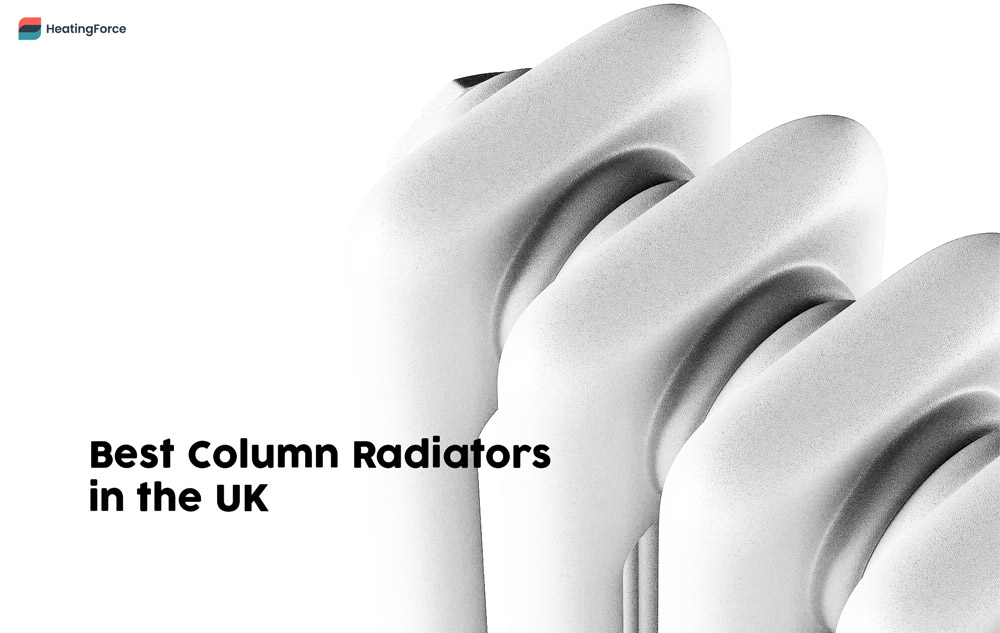
Column Radiators (UK) for Quality and Looks
Today, we’re taking a close look at some of the very best column rads currently on the market. We make our recommendations based on how flexibly the fit into any size or style room, how efficiently they produce comforting heat, and of course how good they look doing it.
- Skip to vertical column radiators
- Skip to horizontal column radiators
Further down the page, we answer your most frequently asked questions about column radiators. Read them through, so that you can conduct your own comparison shopping with informed confidence.
Whether you’re primarily focused on getting the best heat production and efficiency, or you’re looking to transform the aesthetics of your living space, the perfect column radiator is out there for you.
But market research takes time, and you need a solution now. That’s why we’ve gone to the trouble for you, collating this list of exclusively five-star reviewed column rads: vertical and horizontal.
Best Vertical Column Radiators
No matter your personal tastes or BTU requirements, the following are the best vertical column radiators that will fit perfectly.
1. NRG Vertical Oval Column Radiator
If you’re looking for a column radiator which not only does its job but also makes a bold visual statement, look no further than NRG’s line of vertical oval column radiators.
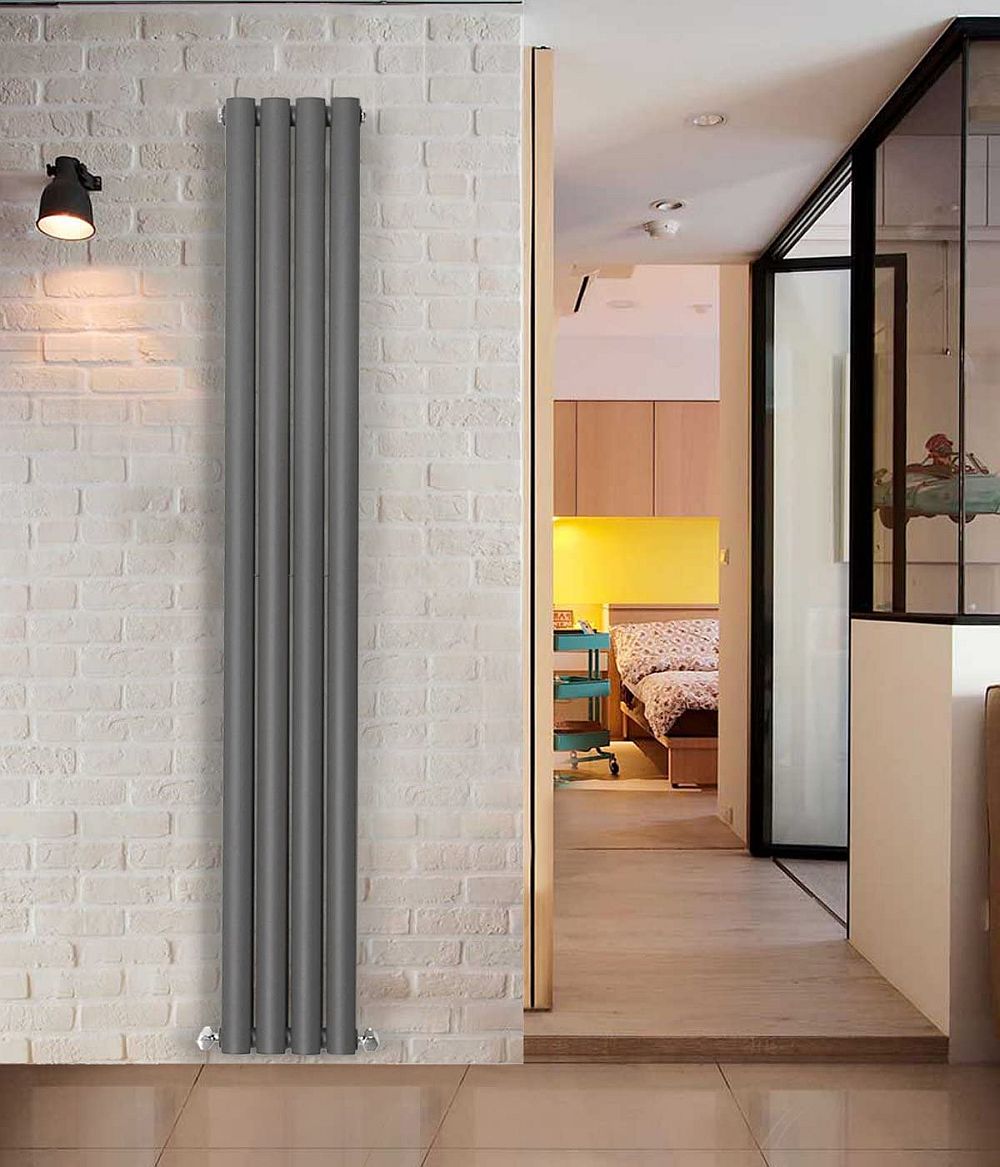
Made from 1.5mm mild steel, the NRG radiator has a low thermal conductance. It warms up slowly, but retains heat once up to speed for superior energy efficiency.
It’s not quite a match for traditional cast iron radiators, but it’s a lot more affordable–and matches modern home décor quite a bit better to boot. Moreover, if you’ve got a smaller room or anticipate turning the heat on and off with any frequency, you’ll actually get better efficiency out of the NRG.
There is a wide variety of sizes and bar configurations to choose from.
The smallest is the 4-bar/single column model at 1600x236mm, which outputs around 2000 BTU; while the largest is a 20-bar/double column radiator at 1800x590mm, which absolutely belts heat at 11480 BTU.
While we’re happy to give NRG the nod for best in class, we can’t help but feel puzzled at the lack of readily available information on which model has what output. We know the endpoints, but you’ll have to take an educated guess as to which will best fit your room size.
Regardless, you will almost certainly enjoy your purchase; with its triple-layered anthracite finish, the NRG vertical oval column radiator is at once handsome, durable, reliable, and excellent value for money.
Pros
- 15-Year warranty
- Wide array of configurations available
- Gorgeous, durable finish
Con
- Quite heavy, install with care
- The manufacturer doesn’t make BTU information easily available only, so you’ll need to estimate which best fits your requirements
2. NRG Vertical Flat Panel Column Radiator
NRG make an early return, snagging both the top spots on our list of the best column rads. From price to performance to variety, their vertical flat panel column radiators are functionally identical to our previous listing, but visually distinct.
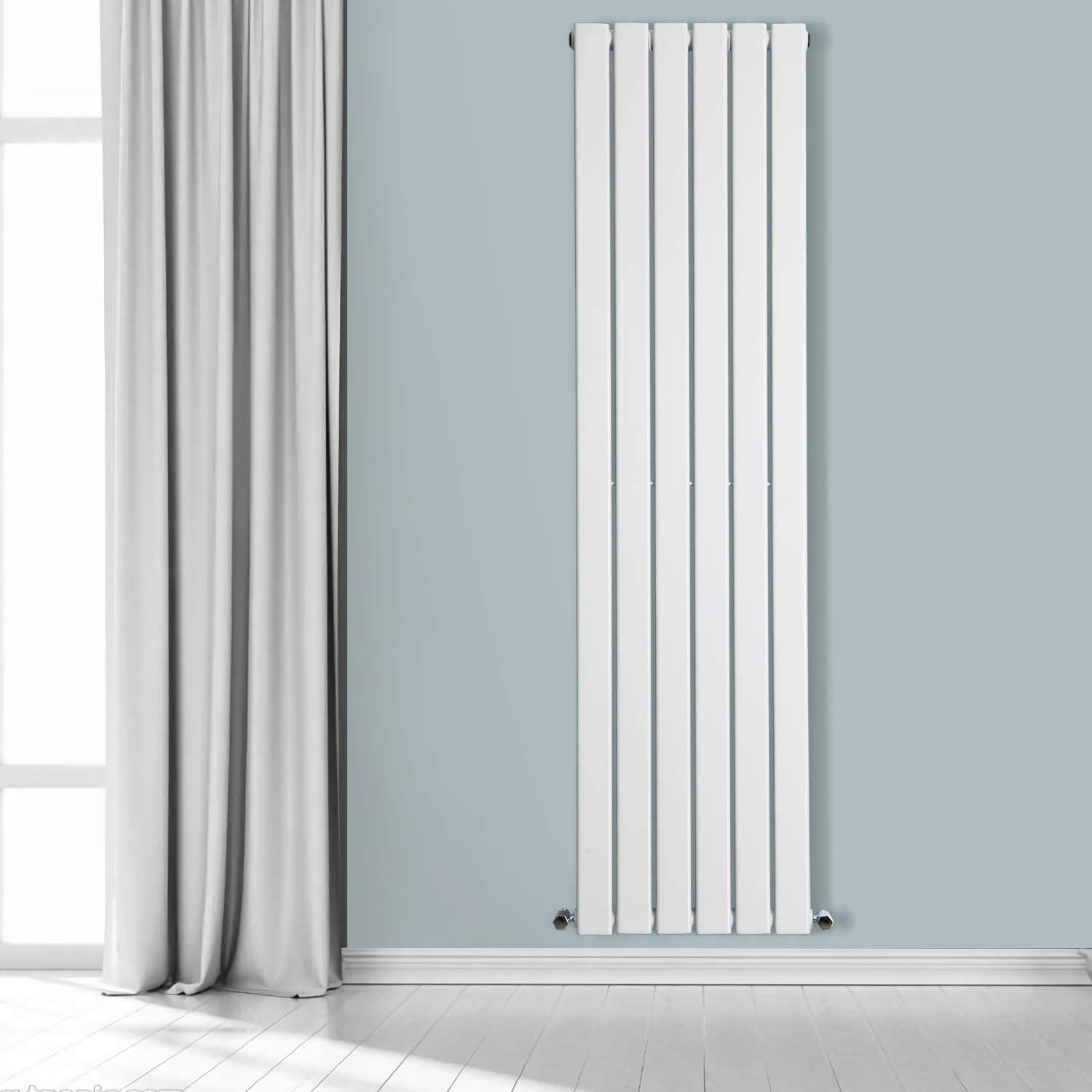
Indeed, while we praised the oval model as bold, the flat panel is even more so! There’s almost a vertical shiplap look going for it, though less organic and more industrial. But don’t confuse this description for something brutalist and imposing; NRG are thoughtful designers who manage to provide plenty of surface area for heating while constraining the visual bulk to a minimum.
Of the two, the flat panel is perhaps less aesthetically flexible in what style of room it best occupies, which is largely why we’ve ranked it second. But subjective taste aside, this is in every way an excellent functional radiator.
Another difference: NRG offers an even wider range of configurations and sizes to perfectly heat any room, for a grand total of 16 models available. These include single and double column radiators, ranging from 4-bar rows at 1600x272mm to 10-bar rows at 1800x680mm. While NRG are strangely tight-lipped on the precise heat output of their various models, you can expect to get anywhere from 2000 BTU to 12000 BTU (and anything in between).
In terms of construction, NRG are top notch indeed. These vertical panel rads are made from 1.5mm mild steel, known for its superior heat-retention properties. They heat up relatively quickly, but are slow to dissipate warmth–radiating a gentle, consistent heat from bottom to top without punishing you via your monthly power bill. Moreover, NRG radiators are solid and durable, with a triple-layered powder coating which resists blemishes, corrosion, and discolouration.
As with all NRG radiators, flat panel column models ship with a 15-year warranty.
Pros
- Outstanding construction, durability, and warranty
- Superior energy efficiency
- Refined, modern aesthetics in anthracite or white finish
Cons
- NRG, please post your BTU measurements!
3. Elegant Vertical Single Oval Column Radiator with Mirror
In terms of aesthetics, column radiators tend to follow a fairly narrow mould. Elegant Showers, however, are not content to deliver another wallflower; their mirrored vertical oval column radiator transcends mere functionalism, elevating virtually any home décor as what can rightfully be called a work of commercial art.
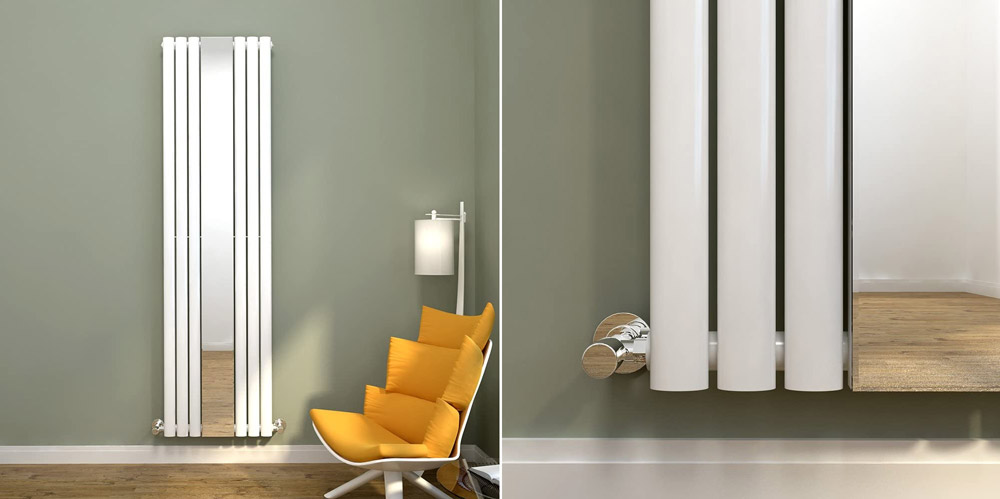
The twin sets of three oval columns contrast yet complement the sharp angularity of the mirror that sits between them, producing an aesthetic that is at once organic yet industrial. It defies easy categorisation, and slots into hyper-modern new home builds as well as rooms with more of an Art Deco or mid-mod vibe. From an interior decorating standpoint, the Elegant mirrored vertical column rad is nothing if not flexible.
Sadly, we lose some of that flexibility when it comes to functionality, though that is no fault of the radiator itself. Elegant only makes the one size at 1800x500mm, which outputs 2750 BTU. We always recommend you match your radiator to the BTU requirements of your room, or risk flushing money down the loo due to inefficiency.
Thus, if your living space deviates significantly from the recommended 55 sq. ft., you will be best served elsewhere. Elegant do indeed offer other vertical radiators with the same oval bar design and higher output, but they lack the mirror.
But if you’re in that size sweet spot, you’ll absolutely fall in love with this one. Indeed, the Elegant mirrored rad produces a sumptuous radiant heat, dispersed with impressive evenness across its entire surface area.
Choose between titanium white or anthracite powder-coated finishes, stress-tested to withstand abrasion, corrosion, and discolouration. You also have flexibility to wall-mount or floor-mount your radiator. Just make sure you hire a professional for installation–you’ll need to prove competent installation to validate the ah-mazing 25-year warranty from Elegant!
Pros
- Incredible styling with oval columns and full-length mirror
- Exceptional heating for 55 sq. ft. spaces
- Best-in-class 25-year warranty from UK manufacturer
Cons
- We’d love more option for sizing
4. Milano Aruba Vertical Oval Column Radiator
Milano are known for their wide range of often colourful column rads (seriously, check out their website for some wild images of fire engine red, yellow, and even pink radiators), and the Aruba vertical oval column rad is their flagship line.
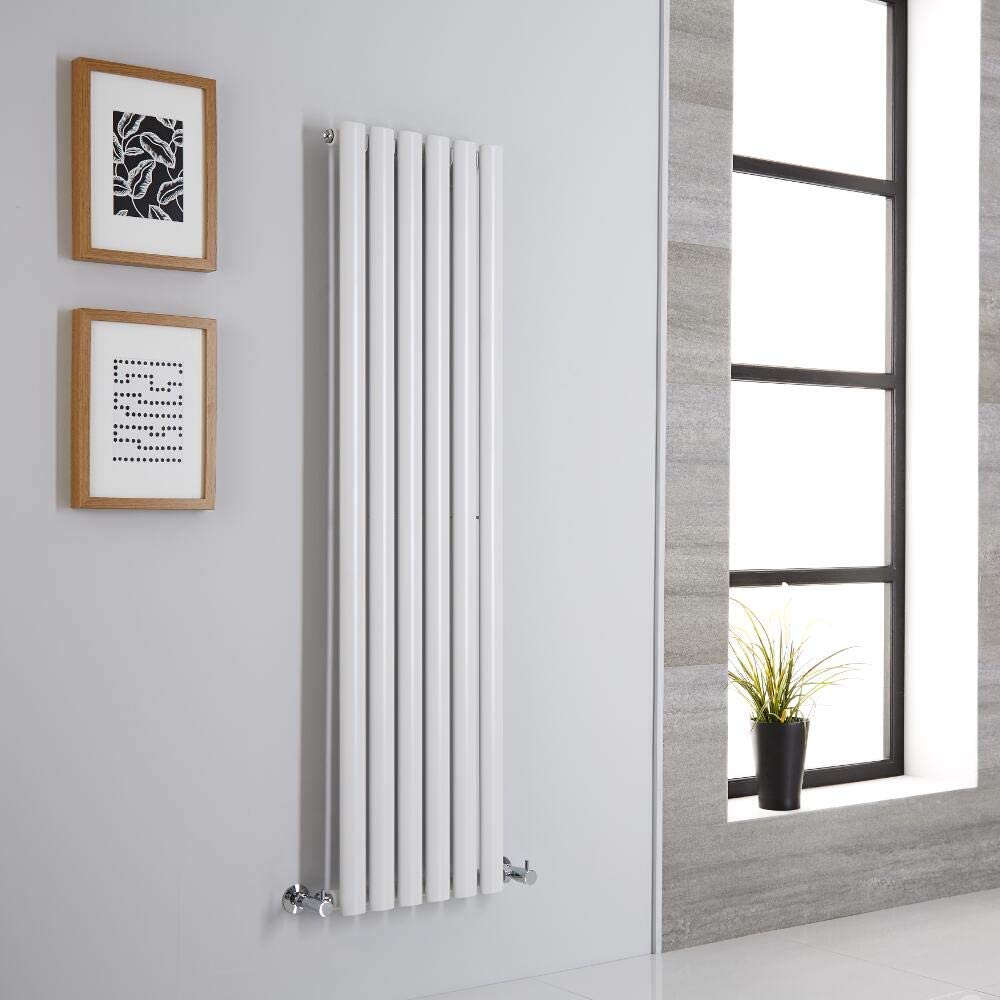
While only white and anthracite are available, this thing still oozes with style and quality; it is sure to add a special focal point to any room.
While Milano likes to play with the Aruba formula (their storefront includes electric versions and even some with Bluetooth control), the core offering comes in the form of their line of single-column radiators. These feature smooth oval-shaped heating bars made of premium quality 1.5mm steel, which possess admirable thermal properties and are exceptionally durable.
Of this line, there are three models on offer: four, six, or eight-bar variants. They all stand 1400mm tall, and their width range from 236mm to 472mm. Mountable either on the wall or on the floor, you’ll have plenty of flexibility to position your lithe, elegant Aruba to optimise your home décor.
But perhaps more importantly, the Aruba puts out a great amount of heat. The smallest of these clocks in at 1737 BTU, ideal for smaller rooms around 34 sq. ft.; while the largest can efficiently warm up rooms as large as 70 sq. ft. with 3468 BTU. While standard steel doesn’t have the heat retention properties of cast iron or mild steel, it does warm up quite a bit faster.
To complete the look of your vertical radiator, Milano also offer a range of colours for valves, though these are not included with the unit itself. But overall, the Aruba’s value proposition is solid, with good build quality and efficiency, and especially considering the 20-year warranty.
Pros
- Easy to install with all fixings and plugs included
- Particularly attractive semi-gloss powder coated finish
- Excellent 20-year warranty
- Blasts heat above what you’d expect for its size
Cons
- Unit is fairly heavy
- Milano ought to bring their full range of colours to the Aruba!
Best Horizontal Column Radiators
No matter your personal tastes or BTU requirements, the following are the best horizontal column radiators that will fit perfectly.
5. NRG White Designer Oval Column Radiator
Much like their vertical cousins, NRG’s horizontal oval column radiators are among the very best in their class. Indeed, these models are among the best-selling currently on the market, due in no small part to an affordable price point, a wide range of sizes to fit any room, an attractive aesthetic, and pure performance.
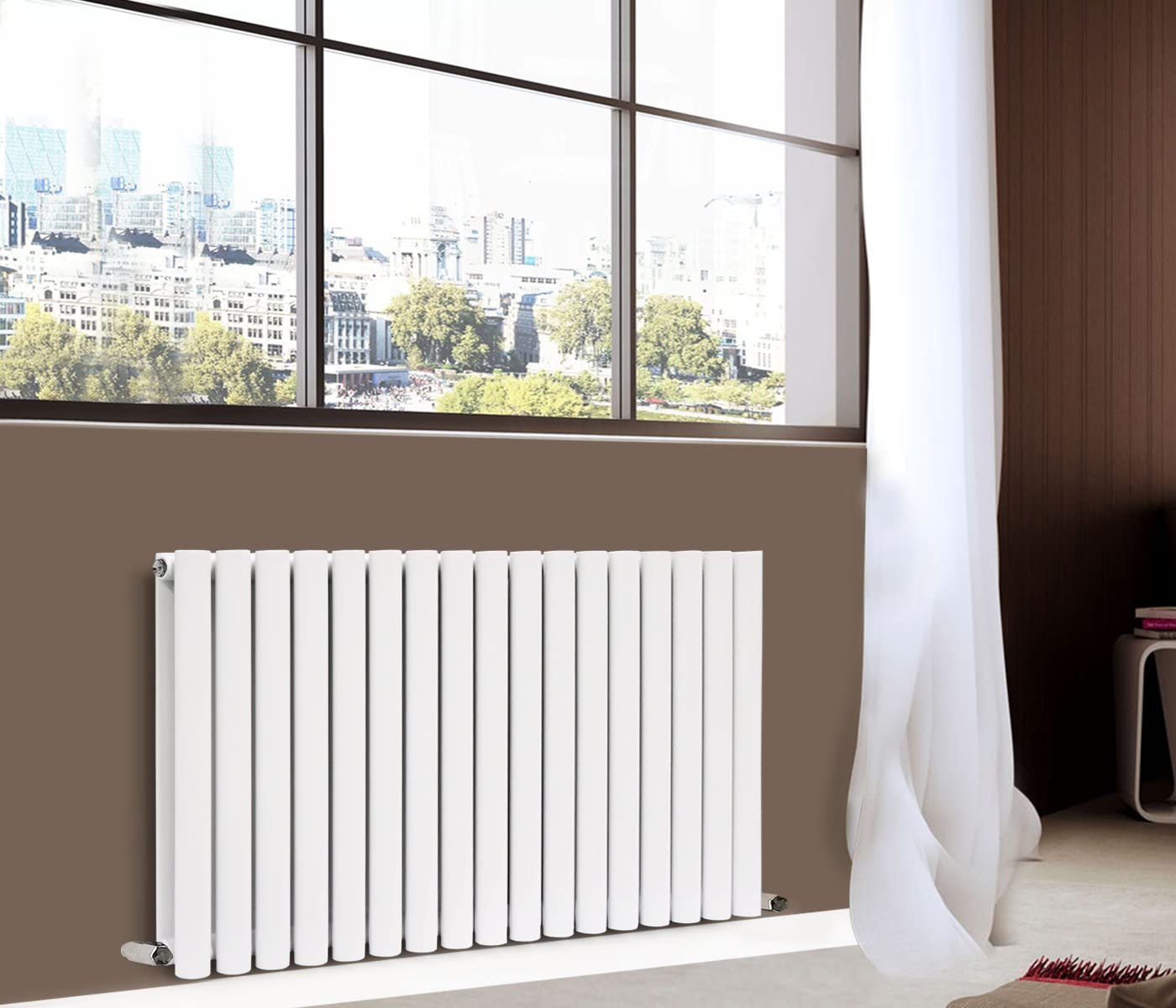
Let’s start with that last point first; NRG are well-known for producing radiators which punch above their weight in terms of how much heat they put out. Even the smallest, single-column variant puts out more than 2000 BTU, bringing much-needed heat to smaller rooms which may not directly benefit from the central heating.
On the other end of the spectrum, NRG offers a colossal 600x1593mm double-row radiator with 54 oval columns for an estimated 14000 BTU–more than enough to fill massive spaces up to 280 sq. ft.! And there are six more models between the two in a variety of single and double column configurations and sizes. True to form, NRG stands by their goal of offering consumers the maximum amount of control over how they heat their homes.
As a rule, horizontal radiators have more mass than their vertical counterparts–even if they’ve got similar surface area. While this means they’re heavier to ship and less wieldy to install, there are real benefits to efficiency. NRG uses 1.5mm mild steel for their columns, which as we’ve said several times throughout this article is a material which retains heat extremely well. So, the increased mass means more steel, and thus more heat retention over the same area.
In terms of durability, there’s nothing more you could ask from NRG; their triple-layer powder coating process provides an attractive surface that resists corrosion, and withstands abrasions and discolouration with equal aplomb.
Pros
- 15-Year warranty guarantees value for money
- Affordable, yet high-quality build
- Smart, modern white powder coated finish
- Extremely efficient
- An ideal height for fitting beneath windows
Cons
- No official BTU numbers from NRG mar an otherwise ideal product offering
6. Milano Aruba Single Panel Horizontal Designer Radiator
Milano also earn the distinction of having multiple entries on our list of the best column rads, in no small part due to their consistent quality and outstanding designs. Whereas NRG are normally the kings of choice, Milano’s Aruba line of designer horizontal column radiators pulls ahead with a whopping 12 choices for sizing and configuration.
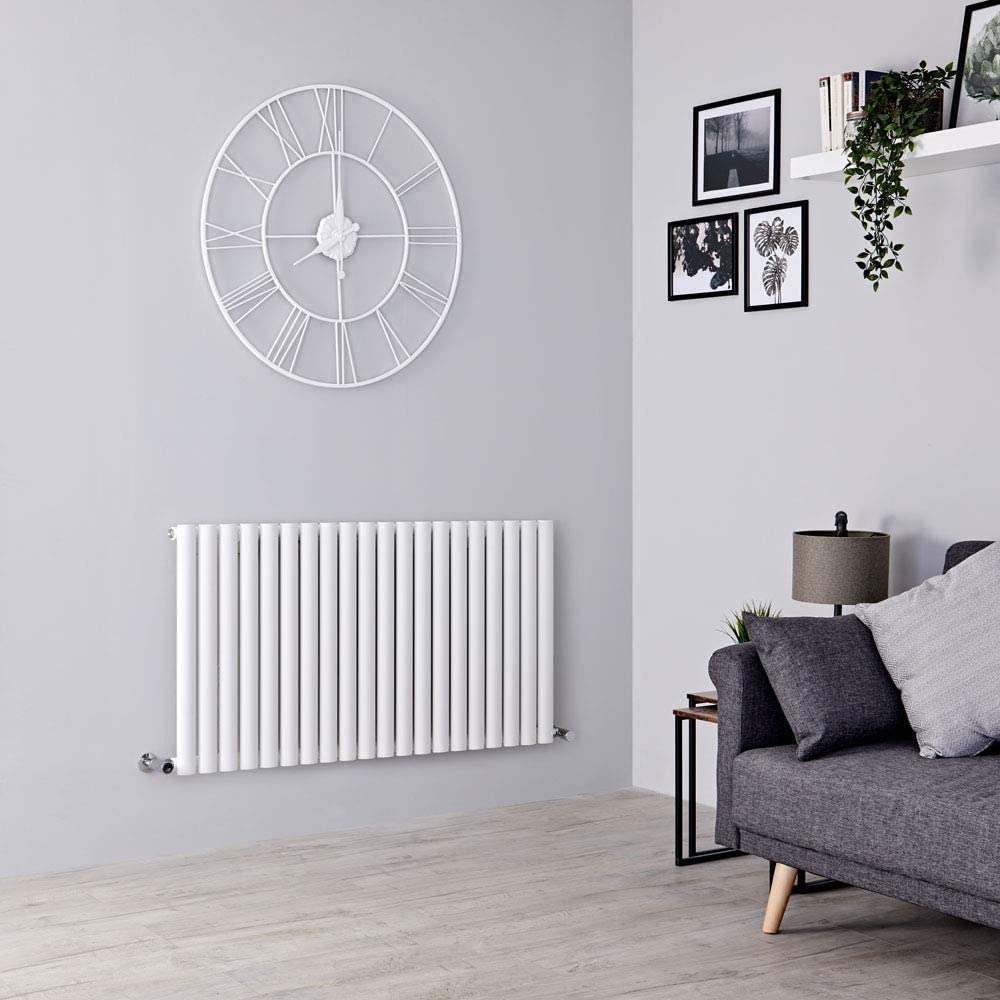
In lockstep with the broader market of luxury rads, Milano offer both single and double-column variants of the Aruba. Both types are quite conservative on vertical space, with nary a model exceeding 400mm. This means the Aruba is a great choice for older homes, which lack the standard window sill height of new builds.
Horizontally, you’ve got a wide array of options as small as 415mm all the way to 1411mm for the titanium white model. Anthracite models get even bigger, topping out at 400x1647mm. So unless you’re trying to heat the largest room in the house, you’ve got two colour options on any model!
For smaller rooms, you have a good amount of flexibility between the single and double column variants. For example, when trying to outfit a 50 sq. ft. space, you’ll be best served by the 400x1000m single column rad (2609 BTU). But don’t have much horizontal space to spare, the 400×595 double column rad provides similar performance (2340 BTU). Such is the beauty of a wide range of options!
Whichever you choose, you will enjoy your posh new radiator for years to come at peak performance. Milano offer an amazing 20-year guarantee on workmanship which is (barring any lemons rolling off the line) hard-wearing and reliable. Even the included mounting hardware is sturdy, and built to last.
Milano’s Aruba are a bit more expensive than most other top-notch column rads; but you definitely get a healthy return on that investment.
Pros
- Outstanding build quality
- Lots of sizing options with overlapping performance to suit any size or style bathroom
- Fantastic 20-year warranty
- Gorgeous finish
Cons
- Higher upfront cost
- Anthracite finish being reserved to the largest models is disappointing
7. iBathUK White Oval Column Horizontal Radiator
If you haven’t already jumped on one of our recommended column rads, maybe you’re looking for a horizontal model with plenty of sizing options, but which doesn’t cost dearly. Then we invite you to peruse iBathUK’s range of single and double oval column radiators, which provides exactly this.
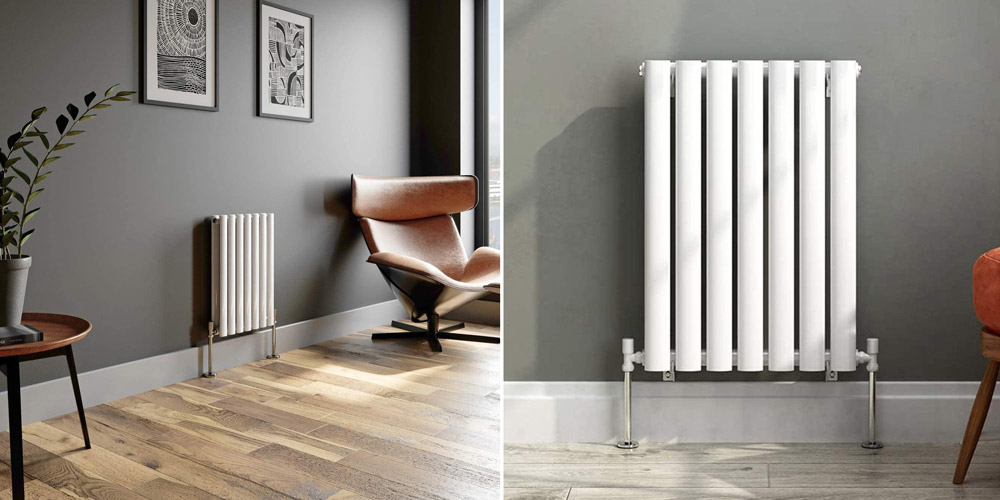
Priced similarly to NRG, you get 11 options to choose from. They’re all the standard 600mm high, and vary from as little as 420mm to as wide as 1620mm–which is nearly as expansive as Milano’s line!
…You’re probably expecting us to drop a big fat “but” to preclude the notion that you can, indeed, have the best of both worlds. We’re sorry to disappoint–iBathUK stands firm as one of the most trusted brands in the home heating industry for good reason.
Hang tight, it gets even better; iBathUK are a bona fide UK brand, based in Sheffield. Just like that, the guilt of buying overseas is gone–without compromising on quality or budget.
On their own merits, these are excellent radiators capable of producing a tonne of heat, from 1036 BTU to 6650 BTU. There’s also significant overlap between single and double column models, allowing you to get exactly the amount of heat your room needs without having to make concessions on how much floor or wall space you’ll willing to sacrifice.
iBathUK make use of low carbon steel construction to reduce manufacturing costs, but this is still a good material for efficiency. And, they use a similar triple-layered manufacturing process to NRG, promising exceptional build quality that will last. And, if you need more assurances, iBathUK rads ship with a respectable 10-year guarantee.
Pros
- Great balance of variety, quality, and price
- Outstanding heat production
- Solid warranty from a trusted UK brand
- Fabulous styling
Cons
- Not quite as efficient as mild steel or cast iron radiators
8. NRG Traditional Colosseum Cast Iron Style Radiator
Taking up the rear of the pack is by no means the least of the lot: NRG’s line of colosseum cast-iron style radiators. Of all our recommended column rads, these stand out as the most traditional pick.
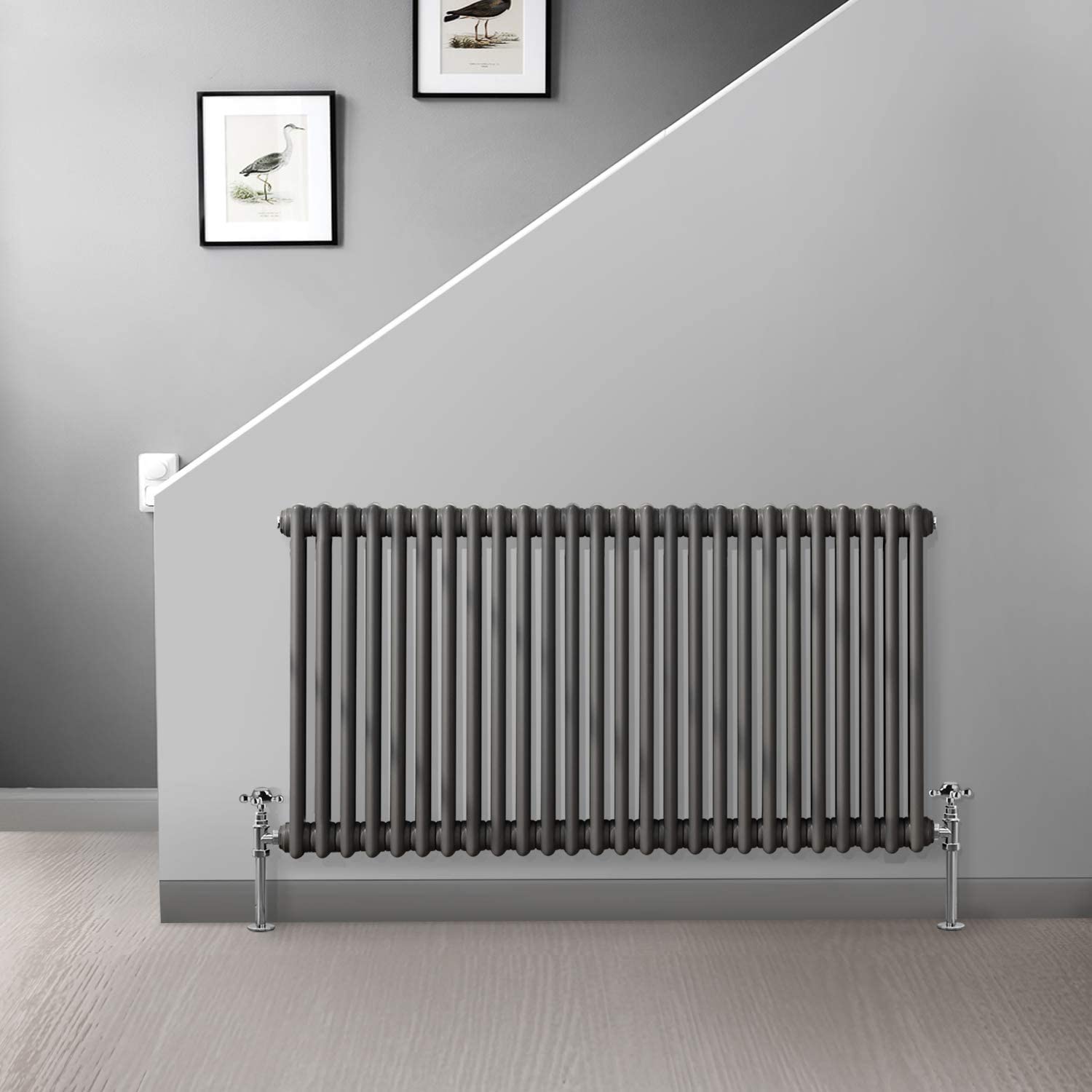
Indeed, their styling is not so much reminiscent as directly modelled on the cast iron radiators of yore. While they look for all the world like what you might find at Nanna’s house, they’re actually constructed of SPCC dead mild steel. This material has a higher carbon content than anything else we’ve mentioned thus far.
Without getting too technical, this material is significantly more workable than cast iron, allowing for affordable manufacture of double and triple column radiators. SPCC steel may lack the ultra-high heat retention of cast iron, but it’s still a highly efficient heating solution in modern homes.
In fact, unless your home has truly gargantuan rooms that require constant heating, you’re actually better off with NRG’s cast-iron style radiator. They are more responsive to your central heating system, and take less energy to get up to stable operational temperatures.
Once again, NRG’s lack of published numbers proves troublesome for shoppers, but combing the websites of their various distributors we’re able to provide some solid figures. The smallest double (600x425mm) puts out 1872 BTU, while the largest triple (600x1460mm) puts out north of 10000 BTU.
Generally, the triple column radiators put out about 40% more heat than double-column models of the same size. In practice, that means that a triple radiator will produce about as much heat as a double column model two sizes up. Keep this in mind, and you should be well able to pick just the right NRG cast iron style radiator to spice up any sized room.
Pros
- Gorgeous rustic design and finish
- Old-world styling with a fraction of the cost
- Impressive performance
- 15-Year guarantee from NRG
Cons
- Some will buy this thinking they’ve scored a killer deal on a genuine cast-iron radiator
- Would love it if they shipped with classic style valves to match
Column Radiator FAQS
Despite being relatively simple as far as heating devices go, there are undoubtedly many questions you’d like answered before making your purchase. Here, we address the most frequently asked ones:
Do column radiators give off good heat?
Absolutely! A well-designed radiator that is properly matched with your room size will put out an impressive amount of heat. The thing to understand about column rads is the type of heat they produce is quite different to that of, say, an electric heater.
With electrical space heaters, there’s usually a heating element which gets super-hot soon after you cut it on, which then pushes this newly created heat into the room with a fan. Because you’re literally causing the element to burn, the air in the room tends to dry out. Moreover, the heat comes directly off the element, and can be harsh to withstand over long periods of time.
Column radiators, on the other hand, work quite differently. By installing into your central heating system (could be a heat pump, tank-fed system, or combi boiler, for instance), they run hot water through all those columns, which slowly absorb the heat. Once they reach a certain thermal capacity, the columns start to radiate (hence the name) a slow, constant heat.
Because there’s no burning involved, the warmed-up air retains its humidity, which comes as a relief to allergy sufferers and those with sensitive breathing issues. Additionally, radiant heat is more natural feeling than convected (fan-blown), feeling more like standing outside under the sun on a May afternoon than in front of a furnace or oven.
And, because there’s so much radiant surface area, the coverage from a column rad tends to be more consistent and evenly dispersed throughout the room. This banishes cold spots and hot spots alike, making for a more pleasant general ambiance.
Are column radiators expensive to run?
Column rads are among the most efficient heating solutions out there. The reason goes back to our explanation of how they produce heat: by slowly absorbing it from the warm water piped through by your boiler, then storing it within the metal columns and slowly radiating it out into the room.
The charm here is that once your radiator is up to operational temperature, you could actually shut down your central heating thermostat altogether. Your radiator would still have a tonne of thermal energy built up, and would continue to slowly disperse it into the air until it’s all gone. Depending on the size of your radiator and the ambient temperature inside, this could take hours.
Put another way, it takes a fair amount of energy to get your radiator up to speed. But once it’s there, it takes barely anything at all to keep it going. If you’re looking for a heating solution that you plan to run day in and day out, then column radiators will serve you extremely well.
One caveat: electric heaters are, perhaps surprisingly, more efficient for intermittent use. While they definitely draw more energy for every minute that they’re on, they hardly take any additional power to “wake up” like a column radiator does. Thus, you’ll burn more energy and get less heat if you try to continually start and stop your water-fed (aka “hydronic”) heater than an electric one.
Can column radiators explode or start fires?
Theoretically yes, but hear us out. A high-quality radiator, if properly installed, should present little to no real risk. Towards the end of its lifespan, however, internal corrosion can add up. This will cause the wall inside the columns to become quite thin. Once this happens, a water pressure spike can blow through these weakened areas, leading to spouts of steam or gushing water.
Other issues can arise from faulty relief valves, which are responsible for ensuring the pressure inside the radiator never gets too great. Typically speaking, the safe upper limit of most modern radiators is around 10 bar, so if it exceeds this cracks and bursts can form.
Water freezing inside your radiator can also cause metal to crack and warp.
While the full list of what can go wrong with your radiator is beyond the scope of this article, it should suffice to say that if you have any doubts about your old radiator, it’s best to call out a licensed plumber to assess its relative health. If you hear any weird new noises, or notice a drop in performance, it could be the sign something’s failing inside.
How long do column rads last?
You typically see manufacturers ship their radiators with warranties between 5 and 25 years. This gives you an idea of how long they’re comfortable standing by the integrity of their products. It’s possible (and recommended) to extend the life further of your radiator with inhibitor, a fluid you put into the radiator that prevents internal corrosion.
But the real answer lies in what type of material your column radiator is made from. This brings us to our next question…
Are all column radiators made of iron?
Not hardly! Cast iron was once the primary material used for radiators, but these days we see mild and low-carbon steel, stainless steel, and even aluminium.
In general, the different materials break down like this:
Cast iron
A traditional, rustic material used in period style radiators. This is an extremely heavy, but also super-durable material that will last the longest of any. Cast iron radiators are slow to heat up, but also slow to lose heat; they are thus extremely efficient long term. By far the most expensive option, but the look and feel are second to none.
Mild steel
This is the most popular material used in column radiators today, primarily because they give good performance yet are inexpensive to manufacture. To get technical, mild steel has a low carbon content, lending it a highly ductile, workable property. Mild steel radiators have a high degree of flexibility in their designs, so you can see them in all shapes, sizes, and colours. They retain heat quite well, though are the most prone to corrosion of all.
Stainless steel
Slightly less workable and significantly more expensive than mild steel, stainless steel is nonetheless an excellent choice for a modern column radiator. It rivals cast iron for sheer durability, and is highly resistant to rust. Thermal retention is excellent, making stainless steel rads an efficient choice.
Aluminium
We didn’t discuss any aluminium radiators in this article, but they’re worth mentioning as a truly modern choice. Unlike iron and steel, aluminium is extremely thermally conductive, and thus will positively belt out heat. This is great if you don’t have a lot of wall space to spare, but have a large room to warm. They require less hot water to bring up to their maximum temperature than the rest, but also dissipate heat the fastest. If you need a hydronic radiator which you can turn on and off repeatedly without excess energy waste, aluminium is an attractive, lightweight, yet durable option.
Does it matter which way I install my column rad?
Usually, yes. Some radiators don’t make a fuss about which side you use as input or output. But the majority have restrictors which force the water through the radiator columns in a specific direction. When installing your radiator, there should be labels on the back of the unit indicating which is which.
Is it necessary to hire a plumber to install my radiator?
If you’ve got the tools, experience, and manpower to lift a potentially heavy radiator into place, then not necessarily. But if you’re short on any one of these factors, we highly recommend you play it safe.
A poor installation not only risks subpar performance and higher energy bills, but it can damage your radiator. And as we’ve previously mentioned, small cracks can lead to big problems in the form of bodily harm or property damage.
Moreover, most manufacturers won’t honour warranties when the quality of the initial installation is in doubt. Hiring a professional plumber will equip you with the receipts you need to prove you did everything right when something goes wrong with your radiator’s workmanship.
Conclusion
Column radiators have been around for a long time. But advances in manufacturing and materials science have cemented their place as a thoroughly modern heating solution. There’s a wide range of attractive options: from ultra-sleek vertical radiators to space-saving horizontal rads to traditional cast-iron style radiators and many more besides.
We’ve reviewed what we believe to be 8 of the very best column radiators on the market today, according to their flexibility, aesthetics, performance, durability, and of course value for money. We’ve also answered many of the most pressing questions people have about column rads in as much detail as we can without getting overly technical.
Which of our recommended column rads most appeals to you? Do you have specific requirements for your space or interior design? What advice would you share with our other readers? Sound off in a comment below, we love to hear from you!